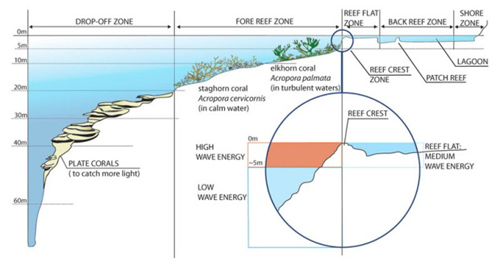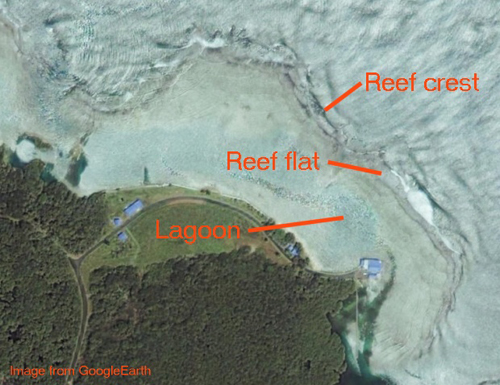Disturbance
In the second topic in this last module, we looked at some of the stresses operating in marine environments and how organisms respond to them. Now we turn to disturbance. We have already looked at disturbance, from a terrestrial perspective, in Module 3. In Module 3, Lindsay defined a disturbance as:
a "relatively discrete event that causes widespread mortality of the dominant species within an ecosystem".
The phrase "relatively discrete event" is important here. When the tide goes out, organisms in intertidal environments may suffer increased stress (depending upon where they are) but the change is gradual – although it can be rapid in some places – and cyclical. Because the change is cyclical, and to some extent predictable, organisms can adapt to the stress; as we have seen in the previous topic. Animals may evolve behavioural strategies to avoid or minimise the stress, as you have seen earlier in the unit; and in the previous topic in this module. Other organisms can have physiological adaptations. Disturbances are different.
1. Disturbance in marine environments
An overview of this topic is given in the following Disturbance in Marine Systems video lecture
presented by Dr Keith McGuinness: https://www.youtube.com/watch?v=nNnv6WuCI-A&feature=youtu.be
The types of events Lindsay described are so severe and extreme that few organisms can experience them and survive (except perhaps as highly resistant stages such as some seeds, spores or similar bodies). Disturbances are not always as large and destructive as the fires and cyclones he describes. On an intertidal rocky shore or coral reef, a large wave may overturn a boulder. This would be a small event on the shore but one which could have severe consequences for the organisms on and under the boulder.
The characteristics defining "disturbance regimes" listed earlier were:
- frequency
- intensity
- predictability
- extent
These are also relevant in marine systems. Here disturbances can be events such as:
- Cyclones and storms – these can be very destructive in intertidal and shallow water environments: Cyclone Tracy destroyed the mangrove forest at Ludmilla Creek and severely damaged sections of forest in the harbour.
- Volcanic eruptions and earthquakes – these can destroy parts of the sea floor and also create giant waves – tsunamis – which are themselves extremely destructive: the 2004 Tsunami, created by a submarine earthquake off the coast of Sumatra, killed a quarter of a million people and devastated coastal habitats and coral reefs in the region.
- Submarine landslides and mud slides – these are the underwater equivalent of the landslides that occur in terrestrial environments and they can be equally as destructive, if not more so: the largest so far documented, the Agulhas submarine landslide off South Africa, moved up to 20,000 km3 of material more than 140 km.
- Low tide exposure – in the previous topic we looked at low tide exposure as a physical stress and, in most cases, it is but in some circumstances it may act more like a disturbance: this is unusual, so is explored in a little more detail below.
- Periods of unusually warm sea temperatures – one of the most commonly observed effects of this type of disturbance is coral bleaching: high temperatures are, however, not the only cause of coral bleaching; it is a general response to high levels of stress.
Before proceeding, read the wikipedia article about disturbance: it outlines the way the term is used in ecology, is a useful review of issues covered so far, and is a good foundation for the rest of this topic. In this topic, we will look primarily at rocky shores http://www.coastalwiki.org/wiki/Rocky_shore_habitat which we examined in the previous topic, and coral reefs.
Coral reefs
Coral reefs are one of the most diverse and spectacular ecosystems on the planet.
Read about the main features of coral reefs, how they form and their biota in the coastal wiki article. Pay particular attention to the discussion of zonation, as the terms introduced there will reappear in the rest of this topic.
Storms, including cyclones, are one common natural agent disturbing coral reef communities: we will look at this in the second part of this topic. Extreme low tide exposures are an unusual type of disturbance which affects some reefs.
Extreme low tide exposures on Caribbean coral reefs
Examine the graphic below (from the coastal wiki article):

Note that the "reef flat zone" is covered by only a shallow layer of water and is frequently exposed at low tide. Most of the time, this exposure acts as a stress and organisms are adapted to survive it. In certain areas of the Caribbean, the tidal range is small; the difference between low tide and high tide being perhaps only 1m or less. The climate on the Caribbean coast of Panama is similar to that of Darwin, with pronounced wet and dry seasons. During the dry season, the wind tends blow constantly and strongly from the north: the waves created wash over the reef crest and reef flat and the tide may not "go out" for weeks or months.
During the wet season, between storms, the wind may die down for hours, or days. If a period of calm weather coincides with a midday spring low tide, the reef crest and reef flat may be exposed to the tropical sun for much of the day. (The reef stinks for days, as the dead algae, animals and other organisms rot: I have been there.)
The image below, from Google Earth, is an aerial photograph of one place where this phenomenon has been studied: Galeta Reef in Panama.

The initial "extreme low tide events" can be devastating for the marine organisms which have developed in the sheltered (from exposure, not waves) conditions during the dry season.
Describing results of a study of zoanthids on the reef flat at Galeta, Sebens (1982) wrote: "All three species are susceptible to massive damage when exposed during abnormally low tide sequences. At any point in time, their distribution patterns reflect both continuously active factors, including competition and predation, and historical events, such as the time of the last major disturbance." (italics added)
In a study, which actually monitored water levels on the reef, Cubit et al. (1986) wrote:
"This paper examines fluctuations in water level over a Caribbean reef flat at Punta Galeta, Panamá. In an analysis of approximately ten years of records, the mean diurnal range of the tides was 24.5 cm and varied <2 cm from year to year. Daily mean water levels varied erratically over a range of approximately 30 cm. Monthly mean water levels fluctuated seasonally over a range of about 10 cm and were consistently higher than those at the regional tidal reference station at Cristóbal. On days with more wave action, water levels at Galeta increased relative to those at Cristóbal, suggesting that waves were ‘pumping’ water onto the reef flat. The monthly mean water levels at the two sites were not correlated, indicating that tidal data from conventional stations in deeper water cannot be extrapolated to reef flats, except as estimates of minimum potential water levels.
Most of the reef flat was within 6 cm vertical span just below mean lower low water. The highest elevations within this range were exposed above water level for an average of 918 hours per year, as compared with 144 hours per year at the lowest elevation. Most exposures lasted less than 10 hours, with a modal duration of 3–5 hours; however, exposures longer than 12 hours occurred at nearly all elevations in all years. Exposures of the reef flat were most frequent between February and June and between August and November, a pattern apparently caused by a combination of seasonal oscillations of regional sea levels, the annual pattern of the solstitial tides, and waves generated by seasonal trade winds.
The fluctuations in water levels apparently affected the abundances of some species of sea urchins on the reef flat. Populations of Lytechinus variegatus and Diadema antillarum declined or disappeared from the reef flat during seasons of repeated subaerial exposures, but recolonized the habitat in periods of higher water levels. Although they are reported to suffer heavy mortality during emersion, Echinometra lucunter and E. viridis did not exhibit reductions in abundance that were synchronous with the seasonal exposures of the reef flat." (italics added)
In this case, low tide exposure acts more like a disturbance because these events are infrequent during the year, rather unpredictable and cause major mortality of dominant organisms.
References
- Sebens, K. (1982). "Intertidal distribution of zoanthids on the Caribbean coast of Panama: effects of predation and desiccation." Bulletin of Marine Science 32: 316-335.
- Topke, Katrien (2008) Coral reefs. Online at: http://www.marbef.org/wiki/Coral_reefs
- Wikipedia. (2009) Disturbance. Online at: http://en.wikipedia.org/wiki/Disturbance_(ecology)
- Wikipedia. (2009) Intermediate disturbance hypothesis. Online at: http://en.wikipedia.org/wiki/Intermediate_Disturbance_Hypothesis